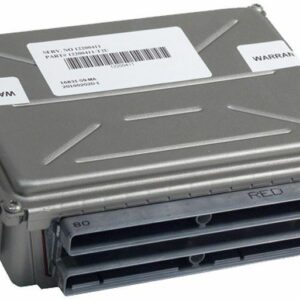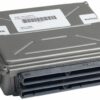Restore Your GM’s Brain and Get Back to Work
Is your 2003 GMC Savana 3500 van giving you headaches? Unexplained stalling, rough shifting, a persistent Check Engine Light, or even a complete no-start condition can bring your work or travels to a grinding halt. As a technician with over two decades of experience, I’ve seen these exact issues countless times. More often than not, the culprit is a failing Powertrain Control Module (PCM)—the central computer of your vehicle. This isn’t just a part; it’s the command center for your engine and transmission. When it falters, everything else does too.
This isn’t just any replacement part. This is a reliable, direct-fit solution for your vehicle. We take the guesswork and dealer-level expense out of the equation. Each 2003 Savana 3500 PCM is meticulously programmed with the latest official GM software updates specifically for your van’s Vehicle Identification Number (VIN). This ensures seamless communication between all your vehicle’s systems, restoring the performance, fuel efficiency, and reliability you depend on. Forget about costly towing and programming fees; this module arrives ready for installation.
Case Study: The Ghost in the Work Van
I once had a 2003 Express van in the shop—a nearly identical platform to the Savana—with a maddeningly intermittent problem. The owner, a plumber, said it would randomly lose power and the transmission would get stuck in one gear (limp mode). He’d already replaced the throttle body and a few sensors with no luck. After connecting my scan tool, I noticed some odd data readings from the PCM but no hard codes. On a hunch, I gently tapped the PCM housing with a screwdriver handle, and the engine immediately stumbled. The problem was internal corrosion on the circuit board, causing intermittent connection breaks. A properly programmed replacement PCM like this one had his van running reliably that same afternoon, saving him from losing more business.
Common Signs of a Failing PCM
If you’re experiencing any of the following, a faulty module could be the root cause. A failing 2003 Savana 3500 PCM can often trigger diagnostic trouble codes (DTCs) like P0601, P0606, or U0100.
- ✔ Check Engine Light is illuminated
- ✔ Vehicle will not start or is difficult to start
- ✔ Poor or erratic automatic transmission shifting
- ✔ Noticeable drop in fuel economy
- ✔ Engine stalling, stuttering, or misfiring
- ✔ Failure to pass an emissions inspection
A Straightforward Guide to Installation
Replacing the PCM is a manageable job for a DIYer with basic tools. In most GM vans of this era, the module is located in the engine compartment. Following these steps will get you back on the road quickly.
- Safety First: Always disconnect the negative terminal from your vehicle’s battery before beginning any electrical work.
- Locate the PCM: On your 2003 Savana, the PCM is typically found in the left-hand (driver’s side) rear of the engine compartment.
- Disconnect Connectors: Carefully unlatch and remove the electrical wiring harness connectors from the old module. Inspect them for any corrosion or damage.
- Remove the Old Module: Unbolt the mounting hardware that secures the old PCM to its bracket or the firewall.
- Install the New Module: Mount your new, pre-programmed PCM in place and tighten the hardware.
- Reconnect and Secure: Firmly plug the wiring harness connectors into the new module until they click into place. Reconnect the negative battery terminal.
- Perform Security Relearn (If Necessary): In some cases, a simple security relearn procedure is required. This typically involves turning the key to the ‘ON’ position for 10-15 minutes. Check your owner’s manual for specific instructions.
Verified Vehicle Compatibility
This module, part number 12581565, is a direct replacement for a wide range of GM vehicles. It is compatible with service numbers 12570557, 12576106, 12576869, 12581565, 89017733, and others. Please verify your vehicle from the list below:
- 2003 GMC Savana / Chevrolet Express Vans (1500, 2500, 3500) – (LH rear engine compartment)
- 2003 GMC Sierra / Chevrolet Silverado Pickups (1500, 2500, 3500) – (LH front under battery, specific engines like 4.3L & 8.1L)
- 2003 GMC Safari / Chevrolet Astro Vans – (LH front by battery)
- 2003 Chevrolet S10 / GMC Sonoma / Chevrolet Blazer / GMC Jimmy – (RH front engine compartment, 4.3L)
- 2003 Chevrolet Suburban / GMC Yukon XL 2500 (8.1L) – (LH front under battery)
- 2003 Chevrolet Avalanche 2500 – (LH front under battery)
- 2004 Cadillac CTS (Base, ID 12581565) – (RH engine compartment)
- 2004 Chevrolet Corvette (ID 12581565) – (RH engine compartment)
After your purchase, simply provide us with your vehicle’s VIN. We’ll handle the programming, ensuring your new 2003 Savana 3500 PCM is a perfect match for your specific configuration.
Frequently Asked Questions
Why do you need my VIN?
Your Vehicle Identification Number (VIN) allows us to program the module with the exact software and calibrations your 2003 Savana 3500 requires. This includes engine size, transmission type, and any specific options, ensuring perfect compatibility and performance right out of the box.
Is this a simple plug-and-play installation?
Yes, for most vehicles. Because we program it to your VIN before shipping, you can typically install it yourself without needing a trip to the dealership for programming. In some cases, a simple security relearn procedure may be necessary, which you can do at home.
Will this fix my Check Engine Light?
If the Check Engine Light is on due to an internal PCM failure (like DTC P0601), this module will resolve the issue. However, if the light is on for another reason (e.g., a bad oxygen sensor), you will still need to fix that underlying problem.
What if my original part number is different?
This module replaces multiple GM service numbers. As long as your vehicle is on our compatibility list, this part will function correctly. The key is the VIN-specific programming we perform.
Do I need any special tools to install this?
No special tools are required. Basic hand tools like a socket set and ratchet are typically all that’s needed to remove the old module and install the new one.



